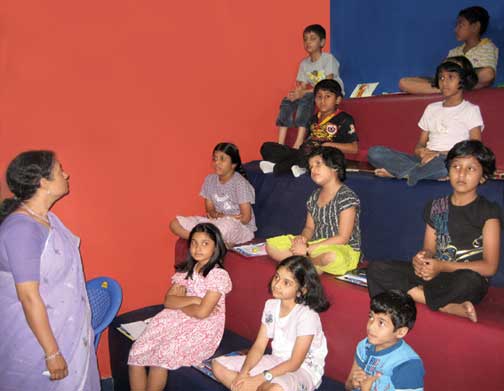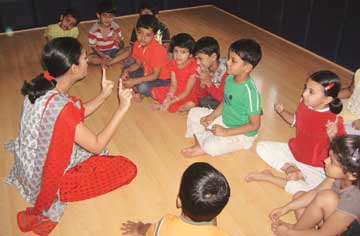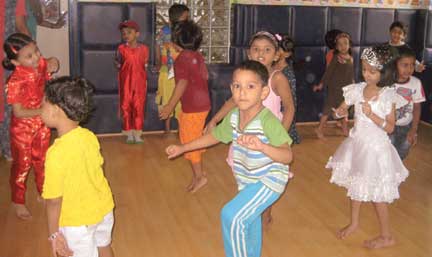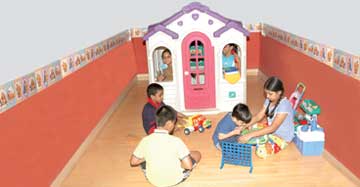Manaswini Sridhar

Fifteen bubbly, excited faces sitting crosslegged in a sprawling, child-friendly airconditioned room for a post-lunch Saturday session. What a challenge! Were they going to yawn and try desperately to keep awake? This was my predominant concern as I studied my ‘little’ students, a batch of 6-8 year olds! Some seemed to know one another since they came from the same locality and the same school; some looked at each other inquisitively, curiously, and with the kind of frank openness that only children seem to possess. Some were little more than babies, and others already have that mature air of ‘I have seen it all’! But they all had their questions…
“Ma’am, are we going to London to write the exam?” (Stunned, but gleeful silence from the rest of the crowd!)
“I was born in London, Ma’am!” volunteered a young boy. (Glances exchanged, with eyes almost popping out!)
“No! How can we go to London? It will be at the British Council. My mother is a member there. I buy books from there.” (You mean ‘borrow’ corrected a wiser one!)
“When is the exam, Ma’am?”
“My neighbor too gave the exam last year. He said it was very nice!”
“What will we be doing, Ma’am? I haven’t brought anything with me!”
“Could we all be quiet so that I can explain…?”
Fifteen pairs of ears and eyes paying rapt attention to the introduction to the Cambridge YLE (Young Learners English) Starters Program. It was obvious that there was so much interest because it was something different, and because a couple of the smarter parents had already made deals with their children on the rewards they would reap if they ‘performed’!
For the little ones, this was the beginning of the programme, but for Vidya, it had begun almost four months earlier when she envisioned her centre Hansel and Gretel becoming a preparatory node for the Cambridge YLE examinations. This meant visits to the British Council to get details of the programme, how one qualifies to become a centre, the minimum number of students a centre needs to enroll in order to have an examination conducted, and of course the costs involved! For me, it began with Vidya’s enthusiastic call and her evident determination and passion to make this programme as successful as her other programmes for children.
 Always open to any kind of new experience, I embraced the idea whole-heartedly. We attended an introductory session to the YLE examinations conducted by the British Council in Chennai. About 70 principals and English teachers from some of the big schools in Tamil Nadu attended the session. Among the guest speakers was the principal of the Madura Coats School, who had already introduced the programme in his school. He gave an insight into the kind of work the programme involved, and the skills that students would develop – reading, writing, listening and speaking. What emerged clearly was that the examination would hold no nasty ‘surprises’ for the student. Students would be exposed to and immersed in a specific number of words and grammatical structures. The examination would be simple and fun, with a minimal amount of writing. The stumbling block for Indian students would be the listening section since our system of education places greater emphasis on writing and reading. The principal vouched that the listening and speaking abilities of his students had improved.
Always open to any kind of new experience, I embraced the idea whole-heartedly. We attended an introductory session to the YLE examinations conducted by the British Council in Chennai. About 70 principals and English teachers from some of the big schools in Tamil Nadu attended the session. Among the guest speakers was the principal of the Madura Coats School, who had already introduced the programme in his school. He gave an insight into the kind of work the programme involved, and the skills that students would develop – reading, writing, listening and speaking. What emerged clearly was that the examination would hold no nasty ‘surprises’ for the student. Students would be exposed to and immersed in a specific number of words and grammatical structures. The examination would be simple and fun, with a minimal amount of writing. The stumbling block for Indian students would be the listening section since our system of education places greater emphasis on writing and reading. The principal vouched that the listening and speaking abilities of his students had improved.
Principals of the local schools agreed that undergoing the training and getting a certificate from the University of Cambridge would indeed be a great honour, however who would train the students? Many of them said that their own teachers were either too squeezed for time or did not have the requisite English skills to train students for the examination. So, where would they turn to for help? Obviously, they would have to rely on freelancers or send their students to centres where there were competent trainers to teach the students. Vidya decided that this was where we came in. With a comfortable, cozy and congenial environment like Hansel and Gretel, a centre for children to play, enjoy and learn, we would probably be able to deliver…that was the seed that was slowly but surely planted in our brains. The next few months were spent looking into the curriculum, making our lesson plans, including various activities that would help reinforce the learning, booking the examination date, putting together tests and report cards and all the other minute details that go into the making of such a programme.
The YLE Starters examination is targeted at 7-8 year olds, the age when children in India have just begun to speak standard sentences, and where spelling has slowly but surely come into place. We decided that a 32-hour session would be adequate to teach the children and grill them through various tests. Thirty-two hours would suffice, provided the parents held hands and guided their children at home, ascertaining that their spellings were in place. In order to make parents understand that this was an added responsibility on their shoulders, we had an orientation course for parents just before the commencement of the course. It was heartening to see mothers, fathers, and in some cases, both, attend the one hour session on a Sunday evening. Parents were anxious about whether it would be any different from the school syllabus and whether the child would get confused. Would they be able to understand the British accent for the listening test? What measures would they have to take in order to make sure that the children did not find the accent too alien? Would their own accent change on account of the exposure, and would that present problems at school? A lot of thought-provoking questions always means that the audience is testing waters and listening…
Thirty-two hours of packed sessions spread over 16 weekends on Saturday and Sunday afternoons. That is the way we had planned it… enough time for the children to wade through the words and get them in place. We divided the vocabulary across 10 sessions, gave them dictation tests, did the jumbled up word exercises for these words in the form of drills on the whiteboard, on paper, as PowerPoint slides and as tests. The diverse ways of learning thrilled and excited the children. They frequently asked, “Will we be going to the TV room today?” The students became so confident by the end of the 26th hour, they declared, “Do not give us the picture! We can unscramble the words without the picture!” Can a teacher ask for anything more?
Since our schools grill students for dictation, I did not expect any problems in this area. But I was surprised that there was no focus on neatness or legibility. The work had to get done…that seemed to be the attitude. There was the fistful that painstakingly made sure that their presentation was at its best, either because they had been taught to do so by their teacher or because they were proud of their work. When I constantly commented on the neatness, their eyes glowed, and they made sure that every single paper presented was neat! Children whose focus was definitely not on neatness were apparently given this not-so-positive feedback until they were convinced that they could not get away with untidiness! It was rather appalling that many children wrote their names on the paper carelessly or illegibly without realizing that the name stood for who they were! Many children crumpled or accidentally tore their answer scripts because they did not understand that the answer scripts had to be handled with care! Shouldn’t schools place more stress on these aspects of ‘education’ rather than just on rote learning?
The tests require minimal writing, but we did focus on handwriting and spelling. Parents later reported that it had done the children a great deal of good that so much of attention was paid to handwriting and legibility. Children too would constantly show their papers to ask, “Neat enough, Ma’am?” To me, that itself was a positive sign, for the child had learned that an improvement had to take place. A comparison had been made, and the child had come to the conclusion that he was not doing his best. We made sure that the comparisons were never harsh. We made observations such as, “Everyone has the same kind of time to do the test. So why is it that some are taking the effort of writing neatly? Don’t we all owe this to ourselves?” This was the kind of egging that the children received and probably because they were a smaller group, they took it in their stride.
The Reading and Writing test is scheduled for 20 minutes. A child can actually do it in 10 minutes, even if it is done at a slow pace. Children look at pictures and answer questions or fill in the blanks as in school compositions. A 20-minute test by Indian standards means writing at least 3 pages. Hence, it was very difficult for the children to initially understand that they were required to write not full-length sentences, but only single words. The focus of the tests was on finding out whether the student had grasped the facts from the picture and from the information given. The composition section proved wobbly for many children although this is a part of the typical school curriculum. Children who had not developed the reading habit found it especially more tedious and cumbersome because they were still struggling with the basic aspects of language, such as collocation and tense. With loads of practice, students were able to cross these hurdles and grasp the fundamentals of language. They understood that words like beach, shell, sand, water, boats form a group while teacher, blackboard, desks, chairs, pencil, paper, etc., belong to another group. By dividing these words visually into various categories, they were able to instinctively choose the right word to fill in the answer. This is where the limited number of vocabulary items helps the students.
The Listening test again is scheduled for 20 minutes, and it is also repeated a second time so that students can check their answers. The task of listening and working simultaneously on a test sheet is a little unnerving for most students. They are unable to correlate a voice to the written text, and then answer questions based on what the voice has said either as a monologue or a dialogue. The British accent makes the process more demanding. So on the first day, students, without making any effort, started groaning and complaining, “I just don’t understand!” “I haven’t got it down!” “Please play it again!” A changed accent and the newness of the test procedure rattled their nerves! They grumbled, cribbed and some even whined. They had no inclination to listen the second time round. If they didn’t get it the first time round, they felt they couldn’t get it at all! So is persistence a quality that has to be taught at home? Should children be taught to understand that there are certain things that will come with time and if it doesn’t happen the first time, then they are not to give up?
 Advice on listening to English songs at home, or watching the BBC channel at home, preferably with their eyes closed, was taken by both parents and children, and soon accent no longer remained a stumbling block. In fact, children became aware of certain discrepancies in pronunciation. They understood the right pronunciation of everyday words like onion, pizza and giraffe! They were learning to ask questions because parents were questioning them about their new pronunciation of individual words. They were intrigued to find that there are different varieties of English, which vary both in pronunciation and vocabulary. For example, they became aware that what was ‘flat’ in British English was ‘apartment’ in American English, and ‘soccer’ was the British word for ‘football’. They found such facts novel and therefore appealing. Some parents said that they were amazed that the child had got interested in English as a language and said that it had been a learning process for them too! That kind of feedback was encouraging.
Advice on listening to English songs at home, or watching the BBC channel at home, preferably with their eyes closed, was taken by both parents and children, and soon accent no longer remained a stumbling block. In fact, children became aware of certain discrepancies in pronunciation. They understood the right pronunciation of everyday words like onion, pizza and giraffe! They were learning to ask questions because parents were questioning them about their new pronunciation of individual words. They were intrigued to find that there are different varieties of English, which vary both in pronunciation and vocabulary. For example, they became aware that what was ‘flat’ in British English was ‘apartment’ in American English, and ‘soccer’ was the British word for ‘football’. They found such facts novel and therefore appealing. Some parents said that they were amazed that the child had got interested in English as a language and said that it had been a learning process for them too! That kind of feedback was encouraging.
The speaking test was something that the children always looked forward to. There were students who said that they wished they could have it more often. Again, this stems from the fact that the questions are clearly formulated, there is a pattern and children have only to think on the spot and answer. The speaking test consists of a picture with objects related to the vocabulary that the children have already learned. There are also object cards that the students have to talk about and place in positions that the examiner asks them to. The speaking test ends with personal questions about the child – his school, family, interests, likes, etc. Children learned a lot of soft skills too like greeting the examiner, having eye contact with the person concerned, staying focused on the questions, thanking the examiner and bidding her goodbye. A lot of the children had to be told to smile and not be so serious! We landed up having quite a few smiling faces by the end of the course.
On the day of the examination, anxious parents milled around, giving their wards last minute instructions of, “Remember, Ma’am has said that you must write neatly.” “Make sure that your tick and cross remain within the box.” “Erase well and then write.” “Remember to greet the examiner when you go in, and thank the examiner when she asks you to sit down.”
After the test was over, when we asked the children how they had done, they said, “It was fun!” That was music to our ears!
About Hansel & Gretel
Hansel & Gretel is a popular children’s activity centre in Chennai that provides a variety of activities for young children in a flexible, relaxed environment. The centre encourages kids to explore, have fun and discover themselves in a stress-free environment, staying true to its motto “Where kids can be kids”.
 Set up with a very pleasing ambience for young children, the centre has been thoughtfully designed with age-appropriate activities in each room. It contains a library/reading room, toys room, puzzles room, a mini theater, an outdoor play area and an air-conditioned classroom that can seat more than 75 kids. The mini theater room has a seating capacity of 30 and is used for audio-visual classes. All rooms are Wi-Fi enabled and have facilities for connecting a computer to the Internet for instructional purposes.
Set up with a very pleasing ambience for young children, the centre has been thoughtfully designed with age-appropriate activities in each room. It contains a library/reading room, toys room, puzzles room, a mini theater, an outdoor play area and an air-conditioned classroom that can seat more than 75 kids. The mini theater room has a seating capacity of 30 and is used for audio-visual classes. All rooms are Wi-Fi enabled and have facilities for connecting a computer to the Internet for instructional purposes.
Besides providing good, wholesome fun, the activity centre equips children with useful linguistic, vocational and social skills, basic reading-writing-arithmetic skills, teamwork, the culture of sharing, etc. The management and staff of Hansel & Gretel have significant international exposure and have assimilated many of the best practices and teaching methods followed at children’s activity centres worldwide.
English language enrichment programs
An important activity that Hansel &Gretel has been conducting for children is English Language Enrichment. This activity, for children aged 3 to 12 years, has been running successfully for more than a year.
The teachers at Hansel & Gretel are fully qualified and specially trained to equip young children with good communication skills and a better understanding of the nuances of the English language. The centre focuses on teaching English in a stimulating and enjoyable way, and on instituting a strong foundation that will develop the children’s confidence in listening, speaking, reading and writing. With small class sizes, Hansel & Gretel ensures that all the children receive individual attention.
One of the centre’s most recent offerings under the Enrichment of English programme is the English Program for the University of Cambridge ESOL YLE Exam. The results of the recently conducted YLE exam are just out and the high percentage of success achieved by the children from Hansel & Gretel is testimony to the quality of the program, teachers and staff at Hansel & Gretel. Of the 15 students from Hansel & Gretel 11 scored full marks and the remaining four missed out by just one mark.
The author is a teacher educator and language trainer based in Chennai. She can be reached at manaswinisridhar@gmail.com.
Related articles
Setting and meeting learning standards
CCE – Is it testing time for teachers?
